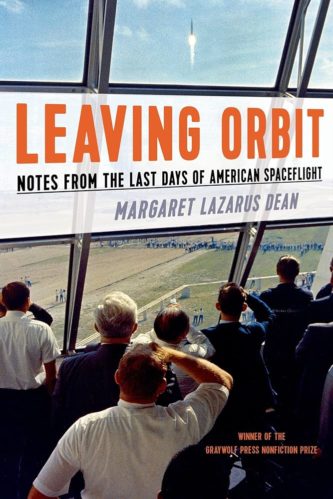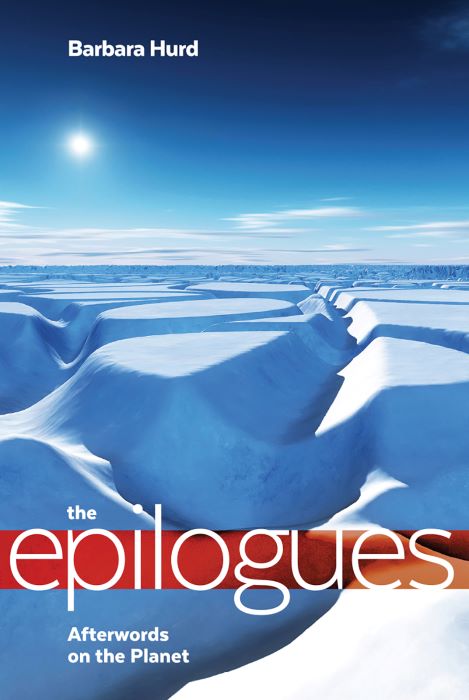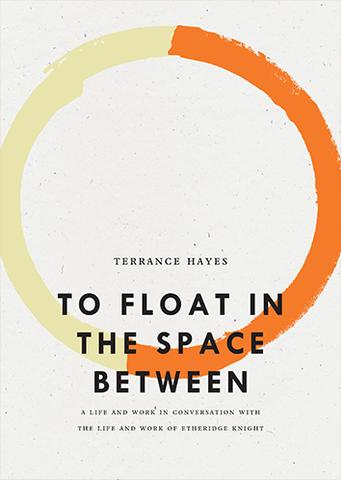By Richard Gilbert
on Leaving Orbit: Notes from the Last Days of American Spaceflight by Margaret Lazarus Dean.
A wizard behind the U.S. space program, German rocket scientist Wernher von Braun, once likened space missions to the ocean voyages of ancient mariners. The analogy seems perfect, but the sea, while harsh, isn’t instantly fatal to shipwrecked sailors. In outer space, frigid and airless, humans can’t live unaided for an instant; a slight rip in an astronaut’s protective suit becomes a mortal crisis; extended weightlessness causes bodily harm. Interplanetary space represents pure death.
Margaret Lazarus Dean chronicles in Leaving Orbit: Notes from the Last Days of American Spaceflight the space program’s tail end, the workaday shuttle phase. Leaving Orbit, winner of the Graywolf Press Nonfiction Prize, also conveys American space exploration’s entire arc, dramatic and distinguished, if compromised and—in Dean’s view—now tragically truncated. Americans’ lack of ambition and imagination about space saddens her:
The history of American spaceflight is a history of doing less than had been planned, less than had been hoped for. Space fans angry about the end of the shuttle seem to think that their disappointment is something new, but in fact the dreams of space enthusiasts have been scaled back from the start. A lunar base, a permanent space station, a reusable spaceship with a booster section that could land like an airplane, a Mars expedition—all these were to have been undertaken by the eighties. Not only were the new projects tabled, but the last three Apollo missions were scrapped before the third crew of moonwalkers landed.
Dean knows that most Americans lost interest after the 1959–1972 “heroic era” of Mercury, Gemini, and Apollo. But she forever imprinted on spaceflight as a girl when her engineer father took her regularly to the Smithsonian National Air and Space Museum. Though insecure regarding her space-geek credibility—she tells herself she immerses so deeply only because she’s a writer—Dean ably explains an enterprise whose details are beyond the lay reader’s comprehension.
But of course accomplishments continued long after the final Apollo expedition to the moon in 1972. At the shuttle’s retirement in 2011, having taken 135 flights over three decades, reusable orbiters had routinized spaceflight; shuttles schlepped payloads as heavy as 50,000 pounds, permitting crews to help build and staff the International Space Station; shuttles carried satellites and the Hubble Space Telescope into orbit; they took the reusable laboratory Spacelab on over twenty flights, enabling experiments in low gravity; shuttles launched probes to study Venus, Jupiter, and the Sun.
Dean believes the explosion of Challenger just after its launch in 1986 and the breakup of Columbia over Texas in 2003 doomed the program. What had seemed, at its worst, another of the Cold War’s necessary evils suddenly made people stop and wonder, Why are we losing lives and spending money this way? Yet the 2008 Wall Street bailouts cost more than the National Aeronautics and Space Administration’s entire existence, Dean observes. NASA’s budget in the shuttle’s final year was below what it cost to air-condition troops in Iraq. The agency’s successes and failures alike appear inseparable from the governmental bargain struck at its core between attainment—of flight prowess, scientific knowledge, and military and commercial spinoffs—and NASA’s comparatively modest, politicized investment.
Author of the 2008 novel The Time it Takes to Fall, about a young Florida girl affected by the Challenger explosion, Dean has immersed in spaceflight history and literature. Here she’s particularly aware of three swashbuckling writers and the books they set in American rocketry’s heroic era: Italian Oriana Fallaci, If the Sun Dies (1966); Norman Mailer, Of a Fire on the Moon (1970); and Tom Wolfe, The Right Stuff (1979). As well as portraying what was ostensibly happening, all three imposed their visions as well as their sartorial identity upon the missions: the glamorous, mercurial Fallaci with her haunted, postwar sensibility; Mailer, the self-proclaimed Hemingway heir, with his rumpled clothes, tousled hair, and self-referential prose; and Wolfe, as outwardly focused as a laser, with his attention-seeking nineteenth-century costume, who made the players in his entertaining account bray like donkeys.
The interplay of zeitgeist and scribe always fascinates. Personal writing and reportage help readers understand phenomena by filtering them through one individual’s history, intellect, and emotions. You’re aware, enjoying Dean’s respectfully curious, friendly persona, how much a period’s colors imbue, in turn, a writer’s work. An aura of loss pervades Leaving Orbit. “Sometimes,” Dean muses, “it seems that Norman Mailer’s generation got to see the beginnings of things and mine has gotten the ends.” And yet, thrilling blastoffs hadn’t changed much. Here’s part of Dean’s witness of a shuttle launch:
And now the sound comes toward us: bassy, crackly, like a fireworks display that never lets up. The sound goes right through you, and if you have become too emotionally involved in the space program, this sound will make you cry. It’s the sound of American exploration, the sound of missiles put to better use than killing or threatening to kill, a sound that means we came in peace for all mankind.
Dean reminds us of the plaque left on the moon’s Sea of Tranquility by Neil Armstrong and Buzz Aldrin: “Here men from the planet Earth first set foot upon the moon. July 1969 A.D. We came in peace for all mankind.” Elsewhere she underscores the message’s inspiring purity. Yet I reflected on how paradoxes within exploration shadow those eloquent words. Throughout history, the wealthy and their governments have piggybacked expansionist aims atop the human yearning for understanding and transcendence. Von Braun’s sailors were both avatars of the human spirit and agents of empire. The Nazis hijacked von Braun’s boyhood dream of interplanetary expeditions to bomb England; after the war, the U.S. nabbed him for the nuclear weapons race. Military goals helped fuel American and Soviet space programs.
While my view of the basic enterprise is less sunny than Dean’s, she rightly focuses upon an upward trajectory.
As the Cold War faded, as spacecraft changed, as the space program passed its zenith, NASA progressed socially along with the outside world. In the shuttle years, the ranks of astronauts were “infiltrated by women, nonwhites, nonmilitary, and nonpilots,” Dean notes. “NASA is no longer looking for the badass loner maverick cowboy; it is looking for team players, people who can keep from getting on each other’s nerves.”
While childcare hadn’t been a concern for Mailer, by then the father of six, Dean notes, she feels guilty for leaving her young son with her husband while researching her books. But if she and her mate are stretched thin, as Dean races for launches from her job teaching English at the University of Tennessee, in Knoxville, at least they’re a team. Although Mailer’s insightful, exhaustive Of a Fire on the Moon seems a touchstone for her, through her eyes we see Mailer’s personal deformity, by today’s standards—not only a consequence of his legendary ego but of his sexist times.
He and I never could have been friends in it. I would not have been allowed to be a writer in it. Or if I had, if I’d managed to make a place for myself as Joan Didion and Susan Sontag did, readers would have hastened to assure each other that, smart as I may have been, I was a bad mother, a bad wife, not pretty or nice enough.
Dean threads through Leaving Orbit a steady and effective feminist critique of the powerful, ruthless males who came ashore at Cape Canaveral—starting with Ponce de Leon, proceeding to von Braun, and culminating in Mailer. By contrast, in the space program’s poignant final stage, Dean captures a dutiful culture. The Kennedy Space Center’s civilian army was there all along—introverted, unabashedly patriotic, soberly careful, dressed in pressed slacks and buttoned shirts—but Dean seems the first author to have seen and extolled it. Spaceworkers, possibly reflecting NASA’s dominant engineering culture, hew to certain values: professional competence, personal restraint, kindness toward others. The right stuff for them wasn’t ever an individual’s attainment but the precise opposite: a larger, group effort toward a greater goal.
Take Dean’s gracious guide. Omar Izquierdo, a thoughtful lay historian of spaceflight, works as an “orbiter integrity clerk,” a shuttle security officer. He connects with Dean on Facebook over her novel, and opens doors for her everywhere at Kennedy Space Center. She effectively dramatizes their interplay, and the reader warms to Omar’s wry, lovable presence. The son of a career NASA engineer who emigrated from Puerto Rico, Omar belongs to the Facebook group “If You Oppose NASA in Any Way I Will Punch You in the Face.” So does Dean. Her admiration for good-guy Omar shines, and he becomes for her and Leaving Orbit the human face of the shuttle enterprise.
The precise nature of Dean’s own passion for spaceflight isn’t clear, beyond the “lovely dream” she grew up with and her implied faith in its heavenly aspirations. But she’s often moved. She touchingly portrays herself crying when Omar spirits her inside the world’s largest structure, the Vehicle Assembly Building, and she gazes into its depths. The iconic VAB, where spacecraft components are mated like giant Tinkertoys, looms so large it makes its own weather: sometimes, the story among workers goes, it rains inside. Dean conveys the manmade scale at Kennedy Space Center amidst a primeval landscape beset by heat and humidity, animated by thunderstorms, and alive with fierce mosquitos, circling birds, bellowing alligators. NASA isolated launch pads three miles from the closest observation bunkers in case of leveling, the horrific end to an accidental blast-furnace explosion. Such security zones in and around Kennedy Space Center form Cape Canaveral’s vast wildlife refuge, the “incidental preservation one of the many strange gifts of spaceflight.”
As well as telling a national and personal story, Dean watches an historic effort’s halt: the final three shuttle launches and return landings. If her documentarian’s hat and dramatized presentation occasionally cause drag, they underscore the moment’s gravity. And Dean’s disappointment and disbelief. Few other Americans seemed to notice or care. Dean’s implication is that they should, and that one day they will. Surprisingly she stokes narrative tension with a simple question, repeatedly asking herself, and by implication her readers, “What does it mean that we went to space for fifty years and then decided not to anymore?” She places spaceflight within aviation’s remarkable history: only 59 years after the Wright brothers took flight at Kitty Hawk, John Glenn orbited the Earth.
Endings are hard. Hard to explain, hard to demarcate. Were the deaths of two shuttle crews pointless losses in a humdrum governmental procedure? Were they heroic sacrifices in an epic narrative? The answer to Dean’s large question about meaning isn’t simple; if she can’t quite answer it, neither can we. It goes to human nature’s enigmatic heart. What America did and shuffled away from? Huge. “Canceling the future,” as Dean sees it in her anger and sorrow. And: “If we wanted to go back to the moon now, we couldn’t do it.” Thanks to her passionate portrayal and inquiry, you’ll shake your head in wonder at the apparent rupture of that legacy.
But Americans still venture into space, now on Soviet ships. And, in October 2015, astronaut Scott Kelly set a new U.S. record for time spent in space, 383 days, aboard the International Space Station. NASA still exists, and helps private firms launch rockets. Dean laments this privatization; it’s clearly a lesser effort than when NASA harnessed its nation’s willpower. By the end of Leaving Orbit, you hope with the author that our flagships will sail again into space, carrying American women and men into that dream for our restless species—our mortal sisters and brothers saying screw you to the hostile void.
Leaving Orbit: Notes from the Last Days of American Spaceflight by Margaret Lazarus Dean
GrayWolf Press
$16.00 paperback | Buy Now!
Richard Gilbert grew up in the Space Coast boom-town of Satellite Beach, the son of a NASA contractor, and in the 1960s and 1970s watched missile launches from his front yard. In April 1981 he was among a team of reporters who covered the first space shuttle launch, of Columbia, for the Orlando Sentinel. Gilbert is the author of Shepherd: A Memoir, a finalist for the 2015 Ohioana Book Award in Nonfiction. His essays have appeared in various journals, including River Teeth, Fourth Genre, Orion, Brevity, and Utne Reader.



































































































































